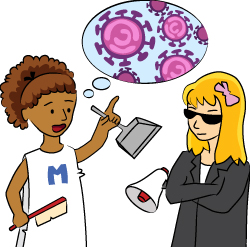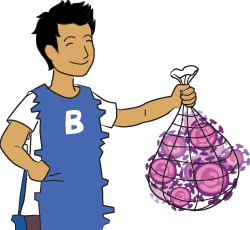What Does Body Repair For You Body
Written by: Kimberly Repp
Illustrated by: Gustavo Castaneda and Yue Huang
How the Torso Repairs Itself
Ouch! You just got a paper cut on your finger. What happens now? Likewise the sting you are feeling from the cut, there are germs on that paper that are preparing to invade your trunk. For your immune system, this means war.
Before you jump in to acquire about how our body defends and repairs itself, take three minutes to lookout man Viral Attack. The flick introduces you to the cells that boxing against germs like leaner and viruses. Afterward the bear witness, yous tin dive into the story and read about each cell.
Invader Alert

An analogy showing germs on paper. As soon as the paper cuts into the cells of your skin, your body springs into action. First, blood cells called platelets join together at the paper cut and grade a clot to stop the bleeding. The platelets then release chemicals called cytokines into your bloodstream. Cytokines attract the attention of sure cells to start healing your cut. They also warning your immune system to scan for infection in the injured surface area. You will notice the injured surface area swelling and getting red as all the cells that the cytokines chosen rush to the scene. This swelling is chosen inflammation.
As soon as the paper cuts into the cells of your peel, your body springs into activity. First, blood cells called platelets join together at the newspaper cutting and form a jell to stop the bleeding. The platelets then release chemicals called cytokines into your bloodstream. Cytokines concenter the attention of certain cells to commencement healing your cut. They also alert your allowed system to scan for infection in the injured area. You will notice the injured area swelling and getting ruddy as all the cells that the cytokines called rush to the scene. This swelling is chosen inflammation.
As the germs from the paper brainstorm to attack your trunk, several different allowed cells also come to help fight them off. In that location are cells that hang out just beneath your skin and wait for germs.
These cells are called neutrophils and macrophages. Neutrophils are a sort of jack-of-all-trades white blood cell. They can defend confronting invaders by eating them, firing anti-microbial proteins at them, or past setting spider web traps exterior of the cells, to catch and kill them.
The macrophages are "big eaters" that function like dump trucks. They go effectually underneath your pare and collect all the "garbage" that isn't supposed to be at that place. The "garbage" can include damaged cells or bacteria that can cause infection.

The lymph system includes the organs and vessels shown hither.
First Response
Neutrophils are the well-nigh common white claret cell in your body, so an invading microbe is about likely to meet a neutrophil first. Neutrophils outset fighting the invaders, and ship off signals to attract other neutrophils and other cells.
Macrophages as well come up into contact with the invader pretty chop-chop. They start eating the invaders that they can, and they report their findings to the lymph nodes.
Two types of prison cell defenders, inactivated T-cells and B-cells, live in your lymph nodes. Here, they wait for a chain of communication to brainstorm.
The macrophage has to report its findings to a dendritic cell that is also waiting inside the lymph node. The dendritic cell then reports the information to the T-cells and B-cells. Then these cells can activate, and leap into action.
The lymph system is a special route through which immune cells can move around the body.
The major parts of this arrangement include the lymph nodes, the thymus, spleen, tonsils, and bone marrow. In these organs, immune cells grow, multiply, or are recycled, keeping the immune system running. Lymphatic vessels run alongside your veins, delivering immune cells throughout the trunk.

Neutrophils have many means to try to fight off an attack.
At the start of any infection, all invaders are treated the aforementioned. Macrophages tin can eat private germs, but usually aren't able to destroy all of the germ invaders, and then they have to get get help from other cell defenders. Later on a macrophage eats a germ, it takes the most unusual pieces of the germ, called antigens, to your lymph nodes. Here information technology meets the dendritic cells over again. Dendritic cells will have the antigens (like ID tags) from the macrophages and testify them to the inactivated B-cells or helper T-cells.
The neutrophils also try to stop the invasion speedily, but they also telephone call for back up. While swallowing some invaders and spraying others with chemicals, neutrophils send chemical messages to attract more cells to the wound.
More Cell Defenders

The macrophage tells the T-cell what it found.
T-cells
One of the other first defenders, a blazon of T-cell called the helper, acts like the "commander" of your allowed system army. When the macrophage enters the lymph node, it finds the dendritic cell and reports what it found on its patrol of the skin.
The message moves again, up the chain of command. The dendritic cell reports the invaders to the inactivated helper T-cell commander. The helper T-jail cell now knows what kind of invader it's dealing with. It seems a war is needed. The T-cell activates into a full-fledged commander!

The T-prison cell makes a plan of action.
Action Program
If the number of invaders is very, very small, sometimes the neutrophils and macrophages can accept care of it on their ain. This can stop a major infection from starting. But, once the macrophage presents information to a dendritic cell, the commander has to exist told. A plan of action must exist fabricated.
Killer T-jail cell
Sometimes, the danger is great. During times similar this, the torso has special fighters. Just like wrestlers come in dissimilar historic period and weight classes to friction match an opponent, some T-cells are fabricated for certain germs. The special fighter T-cells in your immune arrangement are called killer T-cells. The helper T-cells can become into the lymph node and find the one killer T-cell matched to the invader and call them into the fight.

T-cells to the rescue!
Activate!
The macrophage shows the ID tags (antigens) from the invader to an inactivated killer T-cell. This prison cell then activates and makes more and more copies of itself. This army of killer T-cells will follow the path of cytokines to the injury and begin the full-scale set on confronting the germs.
These activated killer T-cells scan all the skin cells around your newspaper cut. They endeavour to find the special antigen that marks invader cells. The antigen can even alert them to an invader if its hiding inside of ane of your peel cells.
Once that antigen is found, the killer T-cells shoot out cytotoxins that destroy the antigen and any skin cell it has infected. The macrophage then comes and gobbles upward the expressionless, germ-filled pare cells to keep your organization make clean.
B-Cell

The B-cells catch wandering viruses.
Finally, depending on the blazon of germ, the helper T-prison cell tin ask the B-cell to bring together in the fight. This final defender, the B-cell, is important considering it can trap, or marker, the germs that haven't yet infected a prison cell.
The B-cell shoots out antibodies, which we can recollect of as nets. The nets are called immunoglobulins, and they look like the letter "Y". Germs are defenseless in the fork of the "Y" and neutralized so they can't infect your body.
Just like the killer T-cell, the B-prison cell will brand more and more copies of itself in your lymph nodes before it heads to the infection. When nosotros experience bloated lymph nodes, information technology's because our activated B- and T-cells are making armies to fight germs!
Mission Achieved!

Germs that T- and B-cells accept fought off successfully are remembered and so they will be easier to fight in the future.
When all germs are destroyed, the battle is over. The B- and T-cells go back to your lymph nodes, and the macrophage returns to patrol the skin, looking for new infections. The B- and T-cells that have fought the infection in your skin now have experience fighting those specific germs so they become memory cells.
Retentivity cells give your body a great advantage if you get infected past the same germs. The memory B- and T-cells get a huge caput start and tin build their cell armies in half the time during the adjacent germ invasion.
For more data on how the immune system battles invaders in the body, visit Viral Attack.
About the author: Kimberly Repp is a local government public health epidemiologist in Oregon and a graduate of Arizona State University. Her enquiry has shown that surfaces like bathroom counters tin spread affliction – even if they don't look dirty. Then exist sure to ever wash your easily. She likewise teaches at the Health Professions graduate campus at Pacific University in Oregon.
Newspaper cutting prototype by Laurence Facun via Wikimedia Eatables.
What Does Body Repair For You Body,
Source: https://askabiologist.asu.edu/explore/when-body-attacked
Posted by: smithsheight.blogspot.com


0 Response to "What Does Body Repair For You Body"
Post a Comment